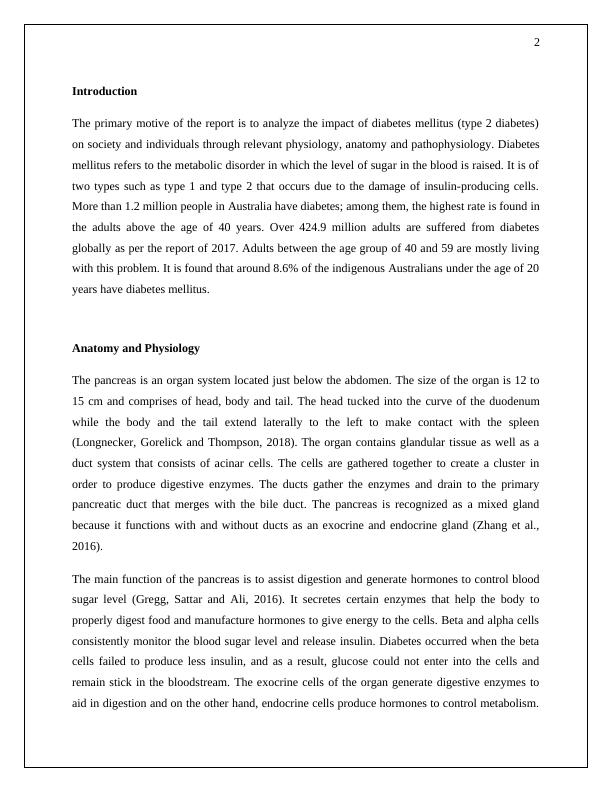Impact of Diabetes Mellitus on Society and Individuals
Added on 2022-10-02
10 Pages2942 Words215 Views
Health and Society
Student's Name:
Student's ID:
Student's Name:
Student's ID:

1
Table of Contents
Table of Contents.............................................................................................................................1
Introduction......................................................................................................................................2
Anatomy and Physiology.................................................................................................................2
Pathophysiology..............................................................................................................................3
Current and new treatment...............................................................................................................4
Social impact of a health problem on the individual.......................................................................4
Impact on society of condition........................................................................................................5
Public initiatives..............................................................................................................................6
Conclusion.......................................................................................................................................6
References........................................................................................................................................8
Table of Contents
Table of Contents.............................................................................................................................1
Introduction......................................................................................................................................2
Anatomy and Physiology.................................................................................................................2
Pathophysiology..............................................................................................................................3
Current and new treatment...............................................................................................................4
Social impact of a health problem on the individual.......................................................................4
Impact on society of condition........................................................................................................5
Public initiatives..............................................................................................................................6
Conclusion.......................................................................................................................................6
References........................................................................................................................................8

2
Introduction
The primary motive of the report is to analyze the impact of diabetes mellitus (type 2 diabetes)
on society and individuals through relevant physiology, anatomy and pathophysiology. Diabetes
mellitus refers to the metabolic disorder in which the level of sugar in the blood is raised. It is of
two types such as type 1 and type 2 that occurs due to the damage of insulin-producing cells.
More than 1.2 million people in Australia have diabetes; among them, the highest rate is found in
the adults above the age of 40 years. Over 424.9 million adults are suffered from diabetes
globally as per the report of 2017. Adults between the age group of 40 and 59 are mostly living
with this problem. It is found that around 8.6% of the indigenous Australians under the age of 20
years have diabetes mellitus.
Anatomy and Physiology
The pancreas is an organ system located just below the abdomen. The size of the organ is 12 to
15 cm and comprises of head, body and tail. The head tucked into the curve of the duodenum
while the body and the tail extend laterally to the left to make contact with the spleen
(Longnecker, Gorelick and Thompson, 2018). The organ contains glandular tissue as well as a
duct system that consists of acinar cells. The cells are gathered together to create a cluster in
order to produce digestive enzymes. The ducts gather the enzymes and drain to the primary
pancreatic duct that merges with the bile duct. The pancreas is recognized as a mixed gland
because it functions with and without ducts as an exocrine and endocrine gland (Zhang et al.,
2016).
The main function of the pancreas is to assist digestion and generate hormones to control blood
sugar level (Gregg, Sattar and Ali, 2016). It secretes certain enzymes that help the body to
properly digest food and manufacture hormones to give energy to the cells. Beta and alpha cells
consistently monitor the blood sugar level and release insulin. Diabetes occurred when the beta
cells failed to produce less insulin, and as a result, glucose could not enter into the cells and
remain stick in the bloodstream. The exocrine cells of the organ generate digestive enzymes to
aid in digestion and on the other hand, endocrine cells produce hormones to control metabolism.
Introduction
The primary motive of the report is to analyze the impact of diabetes mellitus (type 2 diabetes)
on society and individuals through relevant physiology, anatomy and pathophysiology. Diabetes
mellitus refers to the metabolic disorder in which the level of sugar in the blood is raised. It is of
two types such as type 1 and type 2 that occurs due to the damage of insulin-producing cells.
More than 1.2 million people in Australia have diabetes; among them, the highest rate is found in
the adults above the age of 40 years. Over 424.9 million adults are suffered from diabetes
globally as per the report of 2017. Adults between the age group of 40 and 59 are mostly living
with this problem. It is found that around 8.6% of the indigenous Australians under the age of 20
years have diabetes mellitus.
Anatomy and Physiology
The pancreas is an organ system located just below the abdomen. The size of the organ is 12 to
15 cm and comprises of head, body and tail. The head tucked into the curve of the duodenum
while the body and the tail extend laterally to the left to make contact with the spleen
(Longnecker, Gorelick and Thompson, 2018). The organ contains glandular tissue as well as a
duct system that consists of acinar cells. The cells are gathered together to create a cluster in
order to produce digestive enzymes. The ducts gather the enzymes and drain to the primary
pancreatic duct that merges with the bile duct. The pancreas is recognized as a mixed gland
because it functions with and without ducts as an exocrine and endocrine gland (Zhang et al.,
2016).
The main function of the pancreas is to assist digestion and generate hormones to control blood
sugar level (Gregg, Sattar and Ali, 2016). It secretes certain enzymes that help the body to
properly digest food and manufacture hormones to give energy to the cells. Beta and alpha cells
consistently monitor the blood sugar level and release insulin. Diabetes occurred when the beta
cells failed to produce less insulin, and as a result, glucose could not enter into the cells and
remain stick in the bloodstream. The exocrine cells of the organ generate digestive enzymes to
aid in digestion and on the other hand, endocrine cells produce hormones to control metabolism.

End of preview
Want to access all the pages? Upload your documents or become a member.
Related Documents
Homeostatic Changes and Treatment of Diabetes Mellituslg...
|7
|2534
|492
Effect of Type 1 Diabetes on Endocrine, Cardiovascular, and Metabolic Systemslg...
|9
|2838
|311
Anatomy and Physiology: Case Studylg...
|6
|1039
|27
Anatomy and Physiology of Diabetes: Symptoms, Treatment, and Impactlg...
|8
|2524
|34
Collaborative Practice Simulation Workbook - Nursing Assessmentlg...
|14
|3452
|94
Diabetes: Anatomy, Physiology, Causes, Symptoms and Managementlg...
|9
|1720
|317
